Macromolecules review - Study guides, Class notes & Summaries
Looking for the best study guides, study notes and summaries about Macromolecules review? On this page you'll find 346 study documents about Macromolecules review.
All 346 results
Sort by
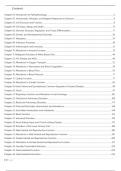 Popular
Popular
-
Test Bank Pathophysiology 7th Edition Banasik
- Exam (elaborations) • 380 pages • 2024 Popular
-
- $17.99
- 1x sold
- + learn more
Test Bank Pathophysiology 7th Edition BanasikContents Chapter 01: Introduction to Pathophysiology ......................................................................................................................................... 2 Chapter 02: Homeostasis, Allostasis, and Adaptive Responses to Stressors ................................................................................. 6 Chapter 03: Cell Structure and Function ...................................................................
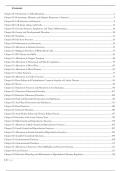
-
Test Bank Pathophysiology 7th Edition Banasik
- Exam (elaborations) • 344 pages • 2023
-
- $17.99
- 1x sold
- + learn more
Test Bank Pathophysiology 7th Edition BanasikContents Chapter 01: Introduction to Pathophysiology ................................................................................................................................. 2 Chapter 02: Homeostasis, Allostasis, and Adaptive Responses to Stressors.................................................................................... 5 Chapter 03: Cell Structure and Function..........................................................................
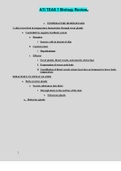
-
ATI TEAS 7 Biology Review
- Other • 59 pages • 2023
- Available in package deal
-
- $8.39
- 1x sold
- + learn more
ATI TEAS 7 Biology Review. a. TEMPERATURE HOMEOSTASIS ¾ skin is involved in temperature homeostasis through sweat glands a. Controlled by negative feedback system a. Receptor i. Sensory cells in dermis of skin b. Control center i. Hypothalamus c. Effector i. Sweat glands, blood vessels, and muscles (shivering) ii. Evaporation of sweat cools body iii. Vasodilation of blood vessels release heat into environment to lower body temperature SEBACEOUS VS SWEAT GLANDS a. Both exocrine gl...

-
Test Bank For Essentials of the Living World 6Th Edition By George B. Johnson Complete All Chapters 2023-2024
- Exam (elaborations) • 118 pages • 2023
-
- $18.49
- 1x sold
- + learn more
Test Bank For Essentials of the Living World 6Th Edition By George B. Johnson Complete All Chapters . The simplest organisms do not have nuclei. In the list below, which group has the simplest organisms? A) Bacteria B) Fungi C) Plantae D) Animalia E) Protista Answer: A Explanation: The Bacteria and the Archaea lack even the nuclear membrane which defines a true nucleus. Please see section 1.1. Section: 01.01 Topic: Levels of Biological Organization Bloom's: 2. Understand Learning O...
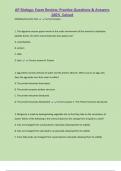
-
AP Biology: Exam Review: Practice Questions & Answers 100% Solved
- Exam (elaborations) • 94 pages • 2024
- Available in package deal
-
- $19.99
- + learn more
AP Biology: Exam Review: Practice Questions & Answers 100% Solved DNA/Biochemestry Test Correct answer--- 1. The digestive enzyme pepsin works in the acidic environment of the stomach to hydrolyze peptide bonds. On which macromolecules does pepsin act? A. carbohydrate B. protein C. DNA D. lipid Correct answer-B. Protein 2. Egg whites consist primarily of water and the protein albumin. When you fry an egg, why does the egg white turn from clear to white? A. The protein becomes d...
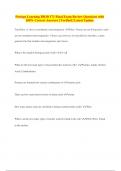
-
Portage Learning BIOD 171 Final Exam Review Questions with 100% Correct Answers | Verified | Latest Update
- Exam (elaborations) • 26 pages • 2024
- Available in package deal
-
- $11.98
- + learn more
Portage Learning BIOD 171 Final Exam Review Questions with 100% Correct Answers | Verified | Latest Update True/False. A virus is considered a microorganism. False, Viruses are not living and as such are not considered microorganisms. Viruses can, however, be classified as microbes, a more general term that includes microorganisms and viruses. What is the smallest biological unit of life? A cell What are the four main types of macromolecules found in cells? Proteins, Lipids, Nucleic Acids...
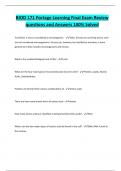
-
BIOD 171 Portage Learning Final Exam Review questions and Answers 100% Solved
- Exam (elaborations) • 25 pages • 2024
- Available in package deal
-
- $15.99
- + learn more
BIOD 171 Portage Learning Final Exam Review questions and Answers 100% Solved True/False. A virus is considered a microorganism. - False, Viruses are not living and as such are not considered microorganisms. Viruses can, however, be classified as microbes, a more general term that includes microorganisms and viruses. What is the smallest biological unit of life? - A cell What are the four main types of macromolecules found in cells? - Proteins, Lipids, Nucleic Acids, Carbohydrates ...
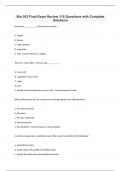
-
Bio 203 Final Exam Review 115 Questions with Complete Solutions
- Exam (elaborations) • 31 pages • 2024
- Available in package deal
-
- $11.99
- + learn more
Bio 203 Final Exam Review 115 Questions with Complete Solutions Nerves are __________ of the nervous system. A. organs B. tissues C. organ systems D. organelles E. cells - Correct Answers a. organs The term "nerve fiber" refers to a(n) __________. A. nerve cell B. organelle in nerve cells C. organ D. axon E. bundle of macromolecules in nerve cells - Correct Answers d. axon What is the primary site on a neuron for receiving signals from other neurons? a. the ax...
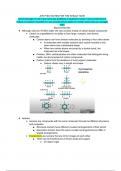
-
AP Biology notes EVERY UNIT! (taught by a Dr. in Biochemistry)
- Class notes • 57 pages • 2024
-
- $14.89
- 2x sold
- + learn more
A 57 page Google doc turned into a pdf that covers everything YOU need to know for AP Biology. My teacher is Dr. John Fuller who has a PhD in biochemistry from UCLA. Dr. Fuller has also done research in labs and contributed to academic papers, one of the most groundbreaking academic papers being about homeobox genes, which just happens to be in the cirriculum for AP Bio. There are also Google slides that Dr. Fuller has made over his 20+ years of teaching AP Biology for unit 8 and other units (...
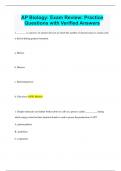
-
AP Biology: Exam Review: Practice Questions with Verified Answers
- Exam (elaborations) • 109 pages • 2024
- Available in package deal
-
- $12.49
- + learn more
AP Biology: Exam Review: Practice Questions with Verified Answers 1. _______ is a process of nuclear division in which the number of chromosomes in certain cells is halved during gamete formation. a. Mitosis b. Meiosis c. Spermatogenesis d. Glycolysis B. Meiosis 1. Simple molecules are further broken down in cells in a process called _________, during which energy stored in their chemical bonds is used to power the production of ATP. A. photosynthesis B. anabolism C. resp...
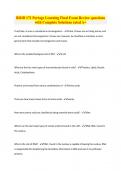
-
BIOD 171 Portage Learning Final Exam Review questions with Complete Solutions rated A+
- Exam (elaborations) • 25 pages • 2024
- Available in package deal
-
- $11.48
- + learn more
BIOD 171 Portage Learning Final Exam Review questions with Complete Solutions rated A+ True/False. A virus is considered a microorganism. - False, Viruses are not living and as such are not considered microorganisms. Viruses can, however, be classified as microbes, a more general term that includes microorganisms and viruses. What is the smallest biological unit of life? - A cell What are the four main types of macromolecules found in cells? - Proteins, Lipids, Nucleic Acids, Carbohydrate...
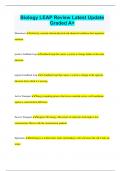
-
Biology LEAP Review Latest Update Graded A+
- Exam (elaborations) • 13 pages • 2024
-
Available in package deal
-
- $9.99
- + learn more
Biology LEAP Review Latest Update Graded A+ Homestasis relatively constant internal physical and chemical conditions that organisms maintain positive feedback loop feedback loop that causes a system to change further in the same direction negative feedback loop A feedback loop that causes a system to change in the opposite direction from which it is moving Active Transport Energy-requiring process that moves material across a cell membrane against a concentration difference ...

Do you wonder why so many students wear nice clothes, have money to spare and enjoy tons of free time? Well, they sell on Stuvia! Imagine your study notes being downloaded a dozen times for $15 each. Every. Single. Day. Discover all about earning on Stuvia


